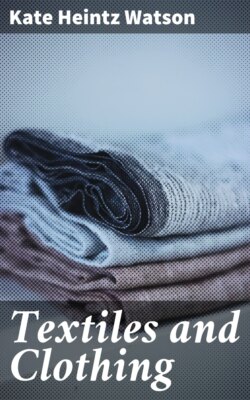Читать книгу Textiles and Clothing - Kate Heintz Watson - Страница 8
ОглавлениеUpland Cotton
The short fiber or upland cotton is the most common and useful variety. It is grown in Georgia, North and South Carolina and Alabama. Texas cotton is similar to upland, but sometimes is harsh with shorter fiber. Gulf cotton occupies a position between upland and sea island cotton.
UPLAND COTTON PLANT WITH FULLY DEVELOPED BOLES
From Bulletin No. 31, Georgia Experiment Station.
COTTON BOLE FULLY DEVELOPED
From Year Book of the Department of Agriculture, 1903.
BOLE OPENED, COTTON READY FOR PICKING
Year Book of 1903.
The Brazilian and Peruvian cotton yields a long staple and is sometimes used to adulterate silk and other fibers. Some varieties of this cotton are harsh and wooly and are prized for use in mixing with wool.
Nankin Cotton
The Nankin cotton grown in China and India and in the southwestern part of Louisiana is characterized by its yellow color. It is used in weaving cloth of various kinds in the "fireside industries" which have become popular in the United States and England.
COTTON FIBERS
A A—Unripe Fibers; B B—Half-ripe Fibers; C C—Ripe Fibers.
Spinning Qualities
Very fine yarn can be spun from cotton because of the spiral character of the fibers. This twist of the fibers is peculiar to cotton, being present in no other animal or vegetable fiber. On account of this twist, cotton cloths are much more elastic in character than those woven from linen, the fibers of which are stiff and straight.
After the removal of the seed, no other fiber is so free from impurities—5 per cent is the loss sustained by cleaning and bleaching. In its natural condition, cotton will not dye readily because of a waxy substance on the surface of the fibers. This must be removed by washing.
Picking and Ginning
Cotton should be picked only when it is fully ripe when the pods are fully burst and the fibers expanded. The unripe fiber is glassy, does not attain its full strength and resists the dye. After picking, the cotton is sent to the ginning factory to have the seed removed. It is then pressed into bales by hydraulic presses, five hundred pounds being the standard bale in the United States.
COTTON BALES
Physical Characteristics
Purified bleached cotton is nearly pure cellulose. It resists the action of alkalis well, but is harmed by hot, strong acids, or if acid is allowed to dry on the fabric. It is not harmed by high temperature, and so may be ironed with a hot iron.
WOOL FIBER AND SUBSTITUTES
1. South American Wool; 2. Noil from the Same; 3. Tangled Waste; 4. Waste Combed Out; 5. Lap Waste; 6. Shoddy.
